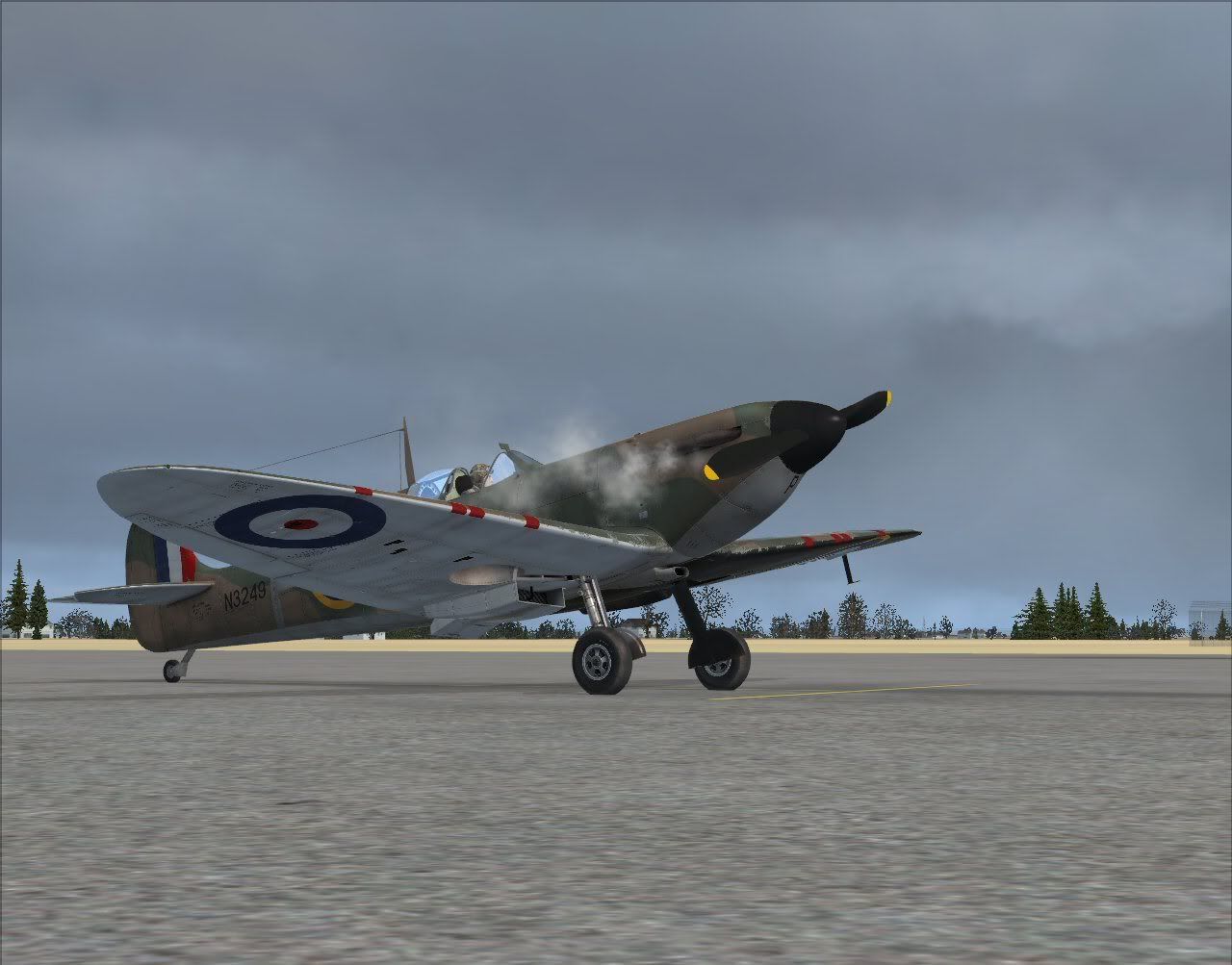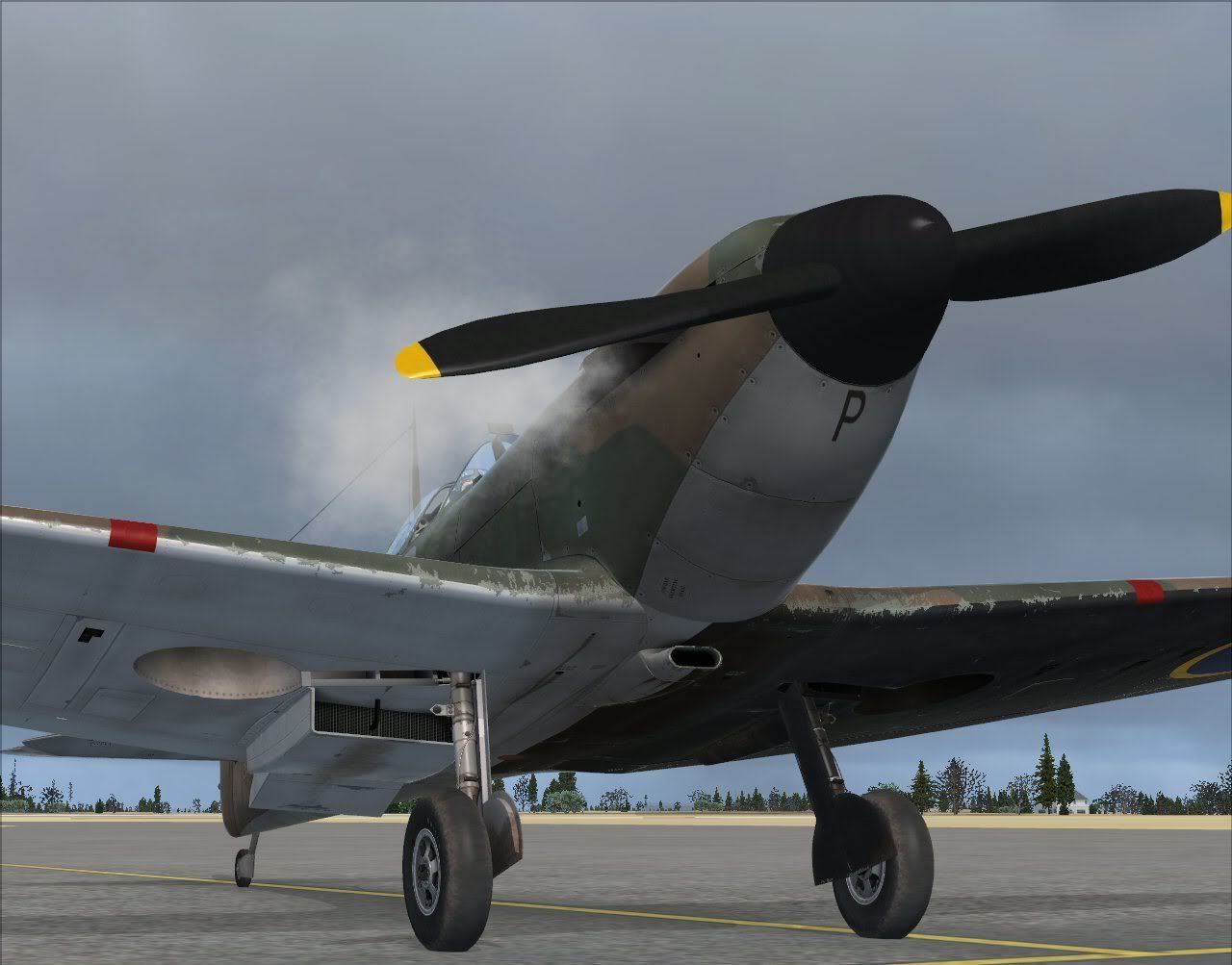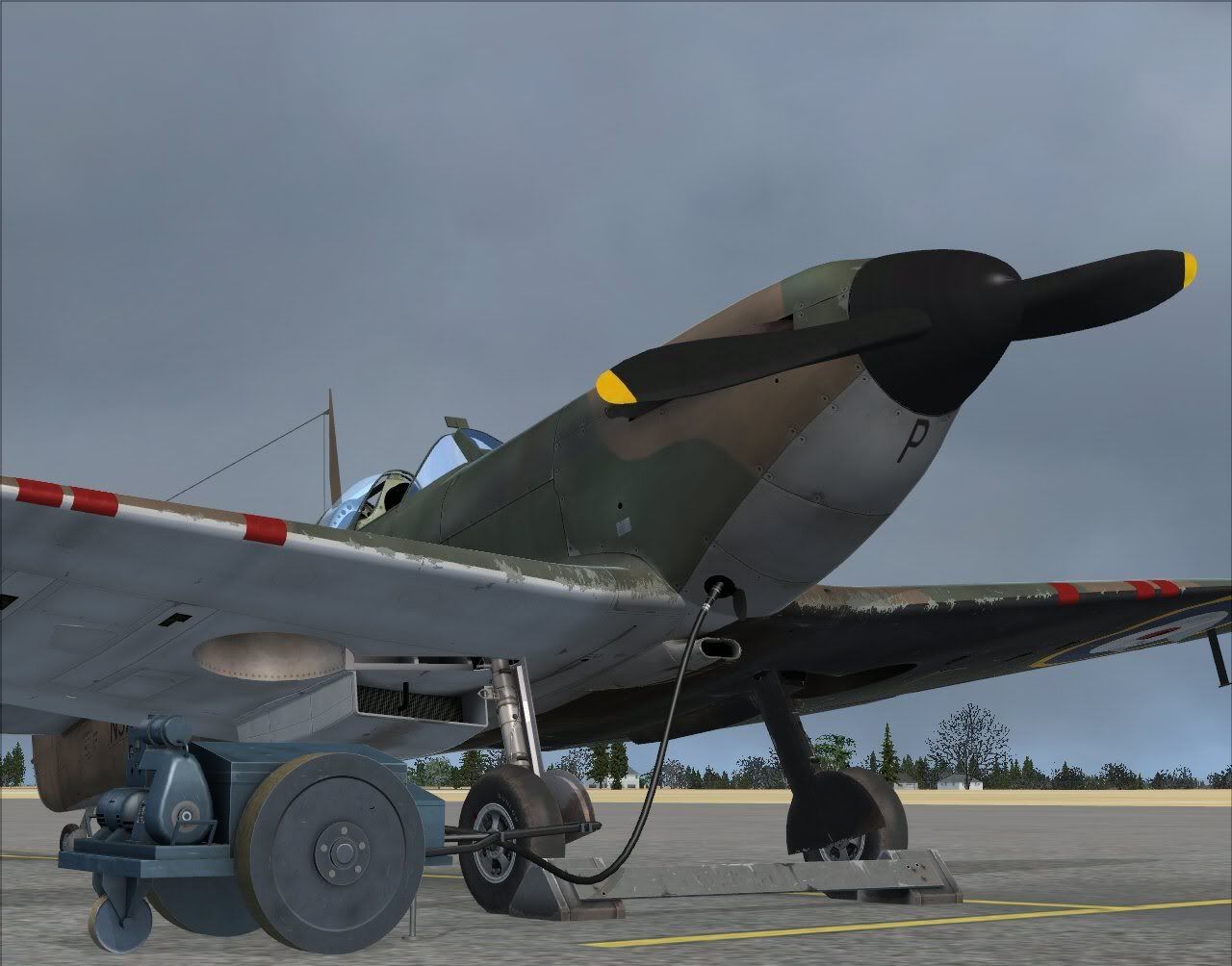Radiator Tutorial.
A LOT of time went into modelling and testing this cooling system (and a lot of
research). It is, simply put, "the goods." It is SO accurate that it creates headaches
for the pilot in almost every conceivable way. The radiator is quite small and despite
the large wing area (often used to good effect with large radiators or cooling pipe
runs spread throughout disappating heat well) the design left hardly any room for
cooling in the wings...in fact WARM air and hot coolant from the engine were ued to
WARM the guns!! Then the U/C legs will block much of the airflow through it.
For these reasons, the Spitfire's radiator, as many of you will already have
experienced, is barely adequate on the ground. It also has some strange qualities in
the air....some of them counter intuitive to a non pilot, some even to a GA pilot.
So here is a quick run-down of points to note, tips to use and traps to avoid.
1. Speed is your friend!!
Remember the Spitfire's lineage? The S6 Racer series. The faster you go the more air
you will force through the radiator...MORE cooling. Unlike most modern aircraft,
throttling back and slowing down will actually RAISE your temps in many cases.
So:
a. Keep Speed ABOVE 180mph when ever possible. This goes for cruising, climbing whilst
still at low altitude, or on initial approach to land. A good cruise speed for economy
and cooling is 200mph. Your range at this speed indicated is about the same whether you
are at 100ft, 1,000ft, or 25,000ft.
b. Use the Radiator Shutter AS suggested. In many regimes of flight the drag from the
radiator will mean that more power (and therefore heat) is required to maintain
airspeed...you can actually raise temps by opening the Radiator Shutter and then trying
to maintain speed! Of course if you let the speed drop, less air is forced through, as
per above.
To give you an example to judge by...If you are at 5000ft and you hit the Boost Cut-Out
Override tab, you will usually get an extra 20-40 miles per hour roughly. This
generates a LOT of heat. So you open your radiator FULL to cool down. This will cost
you about 20-40mph of your speed...... In other words, you go no faster but burn 50%
more fuel and you could still over temp.
2. It is called Normal Flight position for a reason.
So if I slow down I get hotter, if I open the radiator I get hotter, if I power up, I
get hotter and if I do nothing, I get HOTTER??
Well, Yes......and no.
This is where the Normal Flight (red triangle on the map box) Marker comes into play.
In GENERAL at all times when you are cruising, climbs at reasonable boost, on descents,
in the circuit on landing...in fact any NORMAL regime of flight, this is the "Minimum
Drag" setting. It is a compromise and balance between volume of air scooped in and drag
caused by the "scoop" size.
The Merlin is designed to run in this range at temps of somewhere between 60C and 95C
So:
a. USE Normal position for most of the time.
b. Treat temp rises early. Diagnose the "why" work out what can be done and do it. THEN
monitor temps closely to make sure it has had the DESIRED effect.
Something we were always taught in the air... "A bad decision is better than NO
decision". That is particularly true here IF you monitor. Try a suggestion from here,
monitor, if it doesn't stop or reduce the rate of rise, try something else. If it makes
things worse, try something else. The only thing you CAN be certain of, is that IF you
chose to do nothing with rising temps, 9 times out of 10 they will NOT cure themselves.
c. Consider moving the radiator shutter ONE position forward of normal and check its
effect. If you are at 200mph, open it one step..you may cool a bit but only lose
10mph...that is worth the trade off. But if you are at 180mph generally that would be a
bad idea.
3. Other than Normal Flight.
a. For a high power climb the Pilot's Notes suggest opening the radiator shutter
SLIGHTLY, in other words by ONE notch. In extreme temperatures (North Africa?) maybe
two MAY help..but this is a definate "try something else", not an SOP.
b. For slow flying open the radiator an extra notch on normal and do NOT reduce speed
below 180mph without lowering your gear (at which time you may let speed fall to 160).
Use power to maintain this speed at the lowest practical boost and rpm WITHOUT being so
low that the Merlin runs rough.
c. Using the flaps for slow flight is difficult. Above 120mph the power setting
required will overheat you due to disrupted airflow from the flaps. Set RPM higher than
in b. above. In this configuration the temperature should stabilise at approximately
100C.
4. Your other friend is Altitude.
Your Spitfire Mk I or II performs best at between 16,000ft and 20,000ft dependant upon
airscrew OAT, load, etc etc. Use these altitudes.
Maybe 10,000ft is acceptable. 6,000ft to 10,000 ft you should be OK if careful.
Extended operation or high power settings below 5,000-6,000ft are just asking for
trouble.
If you are at 6,000 with a hot radiator..try a moderate power climb at 180mph to 12,000
or 13,000ft.
Circuits...well, I'll leave that to you to work out
5. Check your Airscrew RPM.
Just as the radiator will indirectly affect the oil temp, so the oil temp can drive up
radiator temp with it.
a. Try reducing RPM with the control, not with the throttle. BUT always be aware of the
affect on your speed.
b. When you have tried everything else and only RPM is left, if you have a fixed pitch airscrew,
you could try leaning out of the cockpit and "blowing" on the hot engine...sorry, best
I can think of.
6. Last Resort.
If you really have tried everything else and temps are still climbing, you could try a
moderate power setting dive to increase speed and get some more cooling by opening the
radiator fully and using energy to provide the speed. Make it a SHALLOW one and
remember to bring back the Prop RPM to prevent overseed...
I DO NOT recommend this solution as it can cause a number of problems but as with most
things in aviation, sometimes you must break a rule to survive. I have personally saved
myself on one occasion by doing something as a last resort that was a VERY bad idea at
any other time. You will probably not meet a pilot who has not at one time or another.
The problems to be aware of:
a. Shock cooling of the engine. Rapid descent with a hot engine at low power in
cool air is a bad idea.
b. Prop settings that result in the airscrew driving the engine, not the other way
around. A bad idea.
c. CFIT (Controlled Flight into Terrain)...don't laugh, pilots have died for more
stupid things than getting fixated on watching a radiator temp gauge fall back to
"normal". A bad idea.
d. Uncontrolled Flight into Terrain....the Spitfire must be trimmed into a dive (to
prevent excessive G on pullout). But get too fast in that dive whilst watching the
"pretty green gauge" and you may not get the option of pullout. You guessed it...a bad
idea.
------------------------------------------------------------------------------------
There a any number of wonderful ways to kill your engine, your Spitfire, yourself or
all three at once. There are very few ways fly her correctly.
Prevention is always better than cure. Avoid hot engines in the first place by :
1. Getting your pre takeoff checks and drills learned and then performed efficiently
and quickly but NOT RUSHED.
2. Don't use runways/fields that require extended taxi/hold.
3. As a result of pegging 1 and 2 above, you will get off the ground before temps reach
100C.
4. Climb at moderate power and higher airspeeds unless ABSOLUTELY necessary to go
slower, steeper, climb faster.
5. Watch temps like a hawk below 10,000ft.
6. ALWAYS check coolant levels before flight..remember these levels ARE persistent
between different aircraft of the same Marque.
A final suggestion for those having trouble in the pattern (thanks Dudley). Opening the radiator Shutter to FULL as you turn base may help. The wartime notes advise against it, implying that you aren't doing it right if you have to..however, if you find your temps climbing up...use it to help, if only while you learn.
See how it goes for you.
Clear skys, smooth air and handy tail winds to you all.
Darryl
Killratio's Radiator Tutorial
- CodyValkyrie
- VIP Partner
- Posts: 4560
- Joined: 16 Feb 2007, 03:27
- Contact:
Killratio's Radiator Tutorial
This is buried on the second page of the tips guide, but it is so good it warrents it's own post. Many thanks to Darryl for writing this. I myself am considering doing a tutorial or two in video format.... we'll see how time permits.
Re: Killratio's Radiator Tutorial
if properly followed what is the time frame on a 80 degree day OAT for the engine temp to reach 110. degrees.
I get about 2 minutes seems kind of fast.
I get about 2 minutes seems kind of fast.
Re: Killratio's Radiator Tutorial
Yep, I've tried to read and re-read this tutorial.
I dare say that I preform a little better each time I take her up.
I always d/l "real weather" from the default Jeppesen Metar site.
Alas I dare say that living right smack in the middle of the "Heart of Dixie", it will not be long before it will be blazing hot down here. I'll endeavor to have this mastered by then....thanks a bunch A2A




Tally Ho !
I dare say that I preform a little better each time I take her up.
I always d/l "real weather" from the default Jeppesen Metar site.
Alas I dare say that living right smack in the middle of the "Heart of Dixie", it will not be long before it will be blazing hot down here. I'll endeavor to have this mastered by then....thanks a bunch A2A




Tally Ho !
- Killratio
- A2A Spitfire Crew Chief
- Posts: 5785
- Joined: 29 Jul 2008, 23:41
- Location: The South West of the large island off the north coast of Tasmania
- Contact:
Re: Killratio's Radiator Tutorial
curtis008 wrote:if properly followed what is the time frame on a 80 degree day OAT for the engine temp to reach 110. degrees.
I get about 2 minutes seems kind of fast.
Curtis008, my guess would be that you are idling far too fast..you should have 7-10 miutes depending on OAT...80 F is a "hot " day for Britain but not THAT hot.
Go back and have a read of the general handling notes and checklists and post back if you can't fix the problem. I'l be happy to help.
Darryl
Who is online
Users browsing this forum: Bing [Bot] and 19 guests




